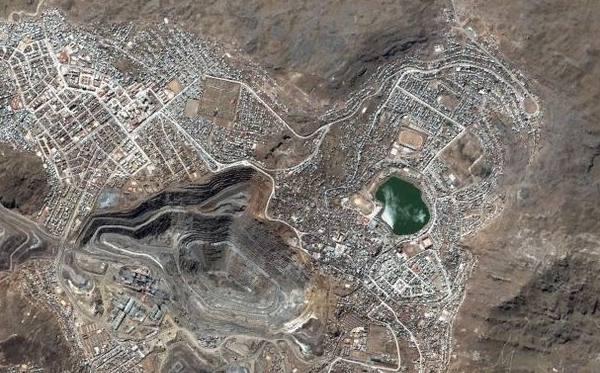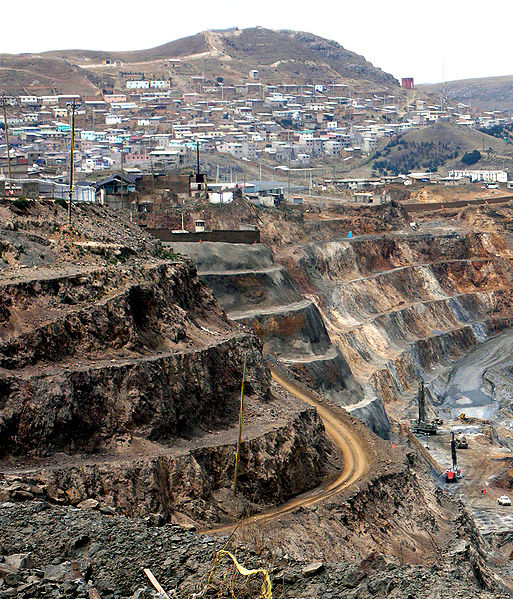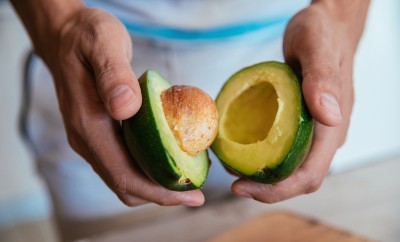Cultures
The Cerro De Pasco Mine Is Eating The 400-Year-Old City

Image: Wiki Commons
The Cerro de Pasco Mine Is Eating The 400-Year-Old City
Located high in the Andes mountains, Cerro de Pasco, Peru is home to a mine that once provided silver to the Spanish crown. This same mine is eating the 400-year-old city and poisoning its children with lead. This quarter-mile-deep mine consumes mostly lead and zinc. In the past ten years, Latin America’s mining sector has tripled in value to $300 billion, and Peru itself derives one-sixth of its gross domestic product from minerals.
Cerro de Pasco has a population of 70,000 and is one of the highest cities on the planet, sitting at 14,200 feet on the treeless Peruvian altiplano.
The open-pit mine located at the center of Cerro de Pasco looks like an inverted ziggurat. It is more than a mile long and a half-mile wide, and it is a quarter-mile deep. The houses with rusted steel roofs lining the Cerro de Pasco mine have been abandoned, and they serve as the barrier between the deep hole and the rest of the city.
Unfortunately, this barrier isn’t enough to truly protect the city from the increasingly dangerous mine. In fact, the Cerro de Pasco mine is one of the worst lead-poisoning spots in the world.
Four hundred years ago, this city had a much different reputation. The mine was ranked by Spain as one of the richest, and Spanish galleons were sent to be filled with its silver. In 1820, Cerro de Pasco was the first in Peru to gain freedom from the Spanish. By the early 1900s, this town was the second largest city in Peru. Exquisite carriages and European consuls were regular appearances throughout the streets.
In 1903, when the world’s highest railroad was completed, Americans were able to cut through the Andes to bring the mine to life. J.P. Morgan, Henry Clay Frick, and the Vanderbilt family were among the first investors. Much of the lead and zinc gathered today is sent to China.
Up until the mid-1950s, the miners used tunnels underneath the city. Then it switched to more efficient open-pit mining—within the city limits. It was later discovered that the richest veins of lead and silver were still under the city.
The open pit has led to dust full of lead piling into playgrounds and backyards. And lakes and rivers are colored orange from the runoff, meaning the drinking water must be shipped from somewhere else via trucks. Water is twenty-five times the cost as it is in Peru. Even worse, judges are still allowing the mining company to dump their waste into nearby ponds. With a lack of water also comes an absence of indoor heating. Inhabitants wear parkas and gloves constantly.

Image: Wiki Commons
Dr. Paul Rodríguez of Cerro de Pasco says he’s seen four cases where children have a blue line across their gums, signaling severe lead poisoning. Sadly, he doesn’t have the resources to order a diagnostic blood test even though government-issued forms require lead levels to be documented to receive help.
Two boys from Champamarca neighborhood, or “lead city,” were found with lead levels at 14.5 and 13.7. The U.S. CDC states that anything above five is incredibly dangerous and life-threatening. One man in the same location measured at a lead level of 18.9 and has experienced three seizures. He came home from the hospital with no medications. Low levels of lead cause fatigue, aching joints, and inhibited learning. Moderate levels permanently lower IQs, while higher levels lead to convulsions, organ dysfunction, and eventually death.
In May 2012 the Peruvian Ministry of Health declared a “state of environmental emergency” in Cerro de Pasco, but the goals set weren’t accomplished. The ministries of Mining and Finance skip out on committee meetings so nothing ever changes. A water system for Cerro de Pasco was just put on pause, because why pour money into a city that’s destined for doom? The common question for those living around the Cerro de Pasco mine is whether to fight or flee, and many have still left that question unanswered.






0 comments